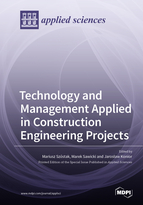Technology and Management Applied in Construction Engineering Projects
A special issue of Applied Sciences (ISSN 2076-3417). This special issue belongs to the section "Civil Engineering".
Deadline for manuscript submissions: closed (30 June 2022) | Viewed by 42550
Special Issue Editors
Interests: occupational health and safety; modeling of the development of accident situations in construction; analysis of the causes of occupational accidents at work in construction; management of construction projects; BIM technology
Special Issues, Collections and Topics in MDPI journals
Interests: technologies and methods of execution of construction works; renovation and demolition works; economics of construction; construction project management; technical life cycle of the facility and construction products; construction scaffolding
Special Issues, Collections and Topics in MDPI journals
Interests: construction project management and quality management in construction engineering and supervision; cost discount and financial control of construction projects; multi - criteria feasibility studies of investment enterprises; qualitative and quantitative research of engineering buildings by probabilistic and fuzzy sets approach; multidiscipline expertise investigations of non - typological buildings samples.
Special Issue Information
Dear Colleagues,
Construction project management is a process that includes a number of operations, activities, and decisions that are closely related to an executed investment and that aim to create new, or to increase, existing fixed assets in order to achieve utility effects. The utility effect of the construction process may be the construction of a new building, or the renovation or modernization of an existing building. In each construction process, according to the definition of the building object's life cycle, the following four basic phases are distinguished: the programming/planning phase, the implementation phase, the operation/use/maintenance phase, and the phase of decommissioning or demolition. Appropriate planning of the entire construction process is a very important operation, which has a direct impact on whether success is achieved when implementing an investment project.
The construction industry is characterized by a high complexity of implemented construction processes, variability of implementation conditions, diversity of facilities, applied technologies, and methods of work organization. The execution of construction projects is specific and particularly difficult because each implementation is a unique, complex, and dynamic process that consists of several or more subprocesses related to each other, in which various participants of the investment process take part.
Therefore, there is still a vital need to study, research, and conclude engineering technology and management applied in construction projects.
We encourage publishing applied results of research on the following topics:
- planning and scheduling of construction projects
- planned, actual, and earned cumulative cost analysis of construction projects
- technologies and methods of execution of construction works
- uncertainty, randomness, and fuzziness of construction projects
- identification of risk sources for the implementation of construction projects
- risk management and mitigation
- value engineering and financial monitoring of construction projects
- full technical life cycle of the facility and construction products
- procurement of contractors for a construction project
- occupational health and safety control
- renovation and demolition works
- BIM technology.
Dr. Mariusz Szóstak
Dr. Marek Sawicki
Dr. Jarosław Konior
Guest Editors
Manuscript Submission Information
Manuscripts should be submitted online at www.mdpi.com by registering and logging in to this website. Once you are registered, click here to go to the submission form. Manuscripts can be submitted until the deadline. All submissions that pass pre-check are peer-reviewed. Accepted papers will be published continuously in the journal (as soon as accepted) and will be listed together on the special issue website. Research articles, review articles as well as short communications are invited. For planned papers, a title and short abstract (about 100 words) can be sent to the Editorial Office for announcement on this website.
Submitted manuscripts should not have been published previously, nor be under consideration for publication elsewhere (except conference proceedings papers). All manuscripts are thoroughly refereed through a single-blind peer-review process. A guide for authors and other relevant information for submission of manuscripts is available on the Instructions for Authors page. Applied Sciences is an international peer-reviewed open access semimonthly journal published by MDPI.
Please visit the Instructions for Authors page before submitting a manuscript. The Article Processing Charge (APC) for publication in this open access journal is 2400 CHF (Swiss Francs). Submitted papers should be well formatted and use good English. Authors may use MDPI's English editing service prior to publication or during author revisions.
Keywords
- engineering technology
- construction management
- project cost
- investment schedule
- risk mitigation
- uncertainty, randomness, and fuzziness
- health and safety control








